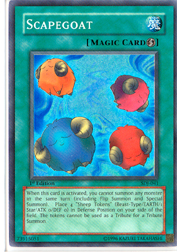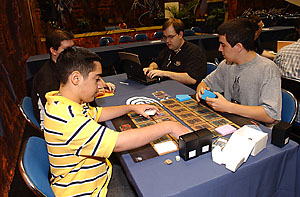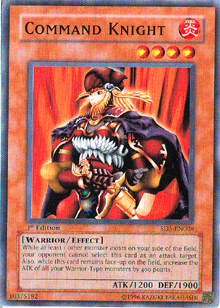Upon the October 1 update to the Advanced format, many duelists looked back at the past few months in which Pot of Greed, Graceful Charity, and Delinquent Duo were legal. Outside of the three spell cards that I just mentioned, there were three cards that really impacted the format. The first was my favorite card in the Yu-Gi-Oh! Trading Card Game. You should all be quite familiar with Tsukuyomi by now, as I tend to mention this awesome Spirit every chance I get! The second major card in the October Advanced format was Metamorphosis. Not only did this card excel as a win condition for aggressive decks, whether they were running Vampire Lord or Cyber Dragon, but it was also the key factor in control decks due to its ability to easily summon Thousand-Eyes Restrict. The third and final card that had a huge impact on the last Advanced format was none other than Scapegoat. This quick-play spell instantly provided its user with a wall of tokens that could be used in conjunction with other spell cards, such as Creature Swap and Metamorphosis. All three of these cards were limited to one copy per deck as of October 1, 2005. Whether or not they will stay on the Limited list remains to be seen.
However, some of these cards have so much flexibility and potential that some duelists may end up playing them incorrectly. Scapegoat, one of the most versatile spells ever to be released, is also one of the most misplayed cards that I’ve seen over the past year.
The Basic Breakdown
 Scapegoat’s effect is easy to understand. You can only activate it if you have four open monster zones, and only if you have not summoned a monster that turn. Scapegoat’s effect will special summon four Sheep tokens to your field in defense position. You’re free to do anything you want with the tokens that were summoned through Scapegoat. However, you’re prohibited from using the tokens for a tribute summon.
Scapegoat’s effect is easy to understand. You can only activate it if you have four open monster zones, and only if you have not summoned a monster that turn. Scapegoat’s effect will special summon four Sheep tokens to your field in defense position. You’re free to do anything you want with the tokens that were summoned through Scapegoat. However, you’re prohibited from using the tokens for a tribute summon.
The first quality to Scapegoat is that is a quick-play spell. Quick-play spells are almost always worth taking a second look at, due to their versatility. They are the only spells that have effects of spell speed 2, meaning that they can be played during your opponent’s turn if they are face down on your field, and they can be activated in response to other card effects that are of spell speed 2 or lower. Quick-play spell cards can be activated at any time from your hand during your turn (excluding the damage step, unless the quick-play spell can modify the ATK or DEF of a monster), and they can be activated at any time during your opponent’s turn, as long as the quick-play spell is on your field.
Scapegoat tends to be a misplayed card either because a player forgets the versatility of their quick-play spells, or they aren’t using Scapegoat in the proper type of deck. In the previous Advanced format, many players occasionally forgot that Scapegoat was the ultimate multi-task card for the Goat Control deck. The tokens were used to either protect its user’s life points or were used as tributes to special summon Thousand-Eyes Restrict, the ultimate removal engine (when combined with Tsukuyomi). However, the fact that you couldn’t summon during the turn Scapegoat was activated caused players to forget that they could still set a monster during the turn that their quick-play spell was activated.
 Matt Peddle is an example of a duelist who’s used Scapegoat in every way possible. During his match against Nareg Torossian at Shonen Jump Indy, it was apparent that Matt was in a dire situation. However, Nareg revealed his Call of the Haunted during Matt’s end phase, targeting the Jinzo in Nareg’s graveyard. Matt saw this as a chance to win, and he activated the Scapegoat that was in his hand in response to build up a defense. This allowed him to survive into his next turn with 1800 life points. That extra turn was all Matt needed to get a clear shot in with the Black Luster Soldier – Envoy of the Beginning that he’d been saving. In the end, it was all for naught, as Matt lost in the third game of his quarterfinal match. However, because of the versatility of quick-play spell cards, he was able to put up a final chance despite the odds against him.
Matt Peddle is an example of a duelist who’s used Scapegoat in every way possible. During his match against Nareg Torossian at Shonen Jump Indy, it was apparent that Matt was in a dire situation. However, Nareg revealed his Call of the Haunted during Matt’s end phase, targeting the Jinzo in Nareg’s graveyard. Matt saw this as a chance to win, and he activated the Scapegoat that was in his hand in response to build up a defense. This allowed him to survive into his next turn with 1800 life points. That extra turn was all Matt needed to get a clear shot in with the Black Luster Soldier – Envoy of the Beginning that he’d been saving. In the end, it was all for naught, as Matt lost in the third game of his quarterfinal match. However, because of the versatility of quick-play spell cards, he was able to put up a final chance despite the odds against him.
The second issue that players tend to have with Scapegoat is that they automatically think that it’s a staple for every deck. While Scapegoat is indeed a powerful card, it isn’t meant to be thrown into every single deck. The summoning of four 0 ATK sheep tokens to your field is counter-productive for decks that wish to be aggressive. Not only are you possibly sacrificing a card slot in your deck that could help you press for more attacks in a duel, but you are also potentially sacrificing more than one turn in which you could be summoning a monster that can attack. This makes Scapegoat a poor deck choice for decks such as Warrior Toolbox, an aggressive deck that attempts to have answers for any of the opponent’s threats each turn.
Scapegoat has more potential in a less stable and slower deck, such as Soul Control and the other Monarch-based tribute decks. In Evan Vargas’s Soul Control build from Shonen Jump Los Angeles, you may notice that he’s running three copies of Scapegoat. His deck needed to have chainable defensive cards with spell speed 2 in order to stabilize his board position against his opponent in the event of a poor draw. However, Scapegoat was also an effective method of providing tribute fodder for cards such as Metamorphosis and Enemy Controller. Both allowed Evan to sacrifice a token, not only to summon Thestalos the Firestorm Monarch, but also to remove a monster from the opponent’s field.
The use of Scapegoat in today’s environment can be questioned, although it does serve a purpose in the Monarch-based decks in the current Advanced format. Despite its restriction, Scapegoat still manages to provide solid defensive options for slower decks.
Combos and Counters
The two most popular uses of the sheep tokens summoned through Scapegoat were to tribute off the tokens through Metamorphosis and Enemy Controller. Both of these cards have seen a decent level of play since April of last year, and Scapegoat easily made both of these spells even more powerful.
 Command Knight is one of my favorite monsters, mainly because it was one of the first cards I saw when getting into the Yu-Gi-Oh! Trading Card Game. I came across its Japanese counterpart early in 2002. While its ATK boosting ability is decent, Command Knight’s self-protection effect is what makes it a strong combo with Scapegoat. When your opponent thinks that he or she may actually be able to destroy Command Knight as a result of battle, you can flip up Scapegoat to force him or her into attacking four more monsters before Command Knight is left vulnerable. For a Warrior Rush-based deck, this can help a player protect the field until they can summon enough monsters to swing into the opponent.
Command Knight is one of my favorite monsters, mainly because it was one of the first cards I saw when getting into the Yu-Gi-Oh! Trading Card Game. I came across its Japanese counterpart early in 2002. While its ATK boosting ability is decent, Command Knight’s self-protection effect is what makes it a strong combo with Scapegoat. When your opponent thinks that he or she may actually be able to destroy Command Knight as a result of battle, you can flip up Scapegoat to force him or her into attacking four more monsters before Command Knight is left vulnerable. For a Warrior Rush-based deck, this can help a player protect the field until they can summon enough monsters to swing into the opponent.
Cannon Soldier and Scapegoat are quite a combination. Scapegoat already adds some decent defense to a fast-paced burn deck, as the Sheep tokens can hold off some of the opponent’s attacks. Scapegoat also acts as a good bluff for spell and trap removal early in the game, which can allow the burn duelist to conserve some of his or her stall cards until the opponent uses up one or two removal options. Once you’re done with your Sheep tokens, you can summon Cannon Soldier to turn those menacing tokens into fireballs to shoot at your opponent. One Scapegoat activation can add up to as much as 2500 direct damage if you tribute Cannon Soldier to its own effect as well, which makes it a very powerful finishing blow.
Final Thoughts
Scapegoat remains a powerful control card. New and old duelists alike should remember that Scapegoat will always remain a strong option for control decks, as the Sheep tokens you’ll get with this spell can be counterproductive in aggressive decks. Within the course of six months, Scapegoat, along with Book of Moon, proved to players how incredibly versatile and deadly a quick-play spell can be. You can always expect to see this card throughout this game’s existence, as a spell speed 2 card that can special summon four monsters tends to be difficult to overlook.
If you have any questions or comments regarding this or previous articles of mine, feel free to email me at Mrosenberg at Metagame dot com.